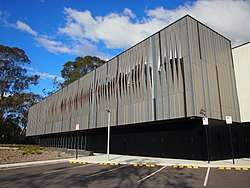National Computational Infrastructure

The National Computational Infrastructure (also known as NCI) is a high-performance computing and data services facility, located at the Australian National University in Canberra, Australian Capital Territory. The NCI is supported by the Australian Government’s National Collaborative Research Infrastructure Strategy (NCRIS), with operational funding provided through a formal collaboration incorporating CSIRO, the Bureau of Meteorology, The Australian National University, Geoscience Australia, the Australian Research Council, and a number of research intensive universities and medical research institutes.
The current director is Professor Sean Smith.
Computer systems
As of November 2017, the NCI operates two main high-performance computing installations, including:
- Raijin, a 1.67 PetaFLOP hybrid Fujitsu Primergy and Lenovo NeXtScale high-performance distributed memory cluster consisting of:
- 84,656 cores (Intel Xeon Sandy Bridge 2.6 GHz, Broadwell 2.6 GHz) in 4416 compute nodes
- 120 NVIDIA Tesla K80 GPUs in 30 nodes and 8 NVIDIA Tesla P100 GPUs in 2 nodes
- 32 Intel Xeon Phi (64 core Knights Landing, 1.3 GHz) in 32 compute nodes
- 4 IBM POWER8 nodes (64 cores running at 4.02 GHz)
- 300 Terabytes of main memory
- Hybrid FDR/EDR Mellanox Infiniband full fat tree interconnect (up to 100 Gb/sec)
- 8 Petabytes of high-performance operational storage capacity
- Tenjin, a 67 TeraFLOP bespoke high-performance partner cloud, consisting of:
- 3200 Intel Xeon cores
- Mellanox 56GB Ethernet – full fat tree topology
- 50TB main memory
- 320TB Solid State Disk
A new supercomputer is expected to be operational at NCI by early 2019.
Data services and storage
NCI operates the fastest filesystems in the Southern Hemisphere, with over 40 Petabytes of disk storage available to users. This is complemented by over 40 Petabytes of archival tape storage on site, with an additional off site redundancy.
Research
Research conducted or under way includes:[1]
- Southern Sky Survey, using the ANU's robotic SkyMapper telescope at Mount Stromlo Observatory
- The Australian Community Climate and Earth System Simulator (ACCESS)
- Medical and materials research
History
The below table is a comprehensive history of supercomputer specifications present at the NCI and its antecedents.
| System (name) | Processor | Memory | Storage | Peak Perf. | Sustained Perf. (SPEC) | Initial
Top500 Rank |
| 1987–92
Fujitsu VP100 |
Vector | 64 MByte | 0.15 GFlops | |||
| 1992–96
Fujitsu VP2200 |
Vector | 512 MByte | 27 GByte | 1.25 GFlops | ||
| 1996–2001
Fujitsu VPP |
Vector/
Scalar |
14 GByte | 28 GFlops | 59 | ||
| SGI Power Challenge XL | 20
MIPS R10000 |
2 GByte | 77 GByte | 6.4 GFlops | ||
| 2001–05
Compaq/HP Alphaserver (sc) |
512
DEC Alpha |
0.5 TByte | 12TByte | 1 TFlop | 2,000 | 31 |
| 2005–09
SGI Altix 3700 (ac) |
1920
Intel Itanium |
5.5 TByte | 100 TByte | 14 TFlop | 21,000 | 26 |
| 2009–13
SGI Altix XE (xe) |
1248
Intel Xeon (Nehalem) |
2.5 TByte | 90 TByte | 14 TFlop | 12,000 | — |
| 2009–13
Sun/Oracle Constellation (Vayu) |
11,936
Intel Xeon (Nehalem) |
37 TByte | 800 TByte | 140 TFlop | 240,000 | 35 |
| 2013–
Fujitsu Primergy (Raijin) |
57,472
Intel Xeon (Sandy Bridge) |
160 TByte | 12.5 PByte | 1195 TFlop | 1,600,000 | 24 |
See also
References
- ↑ "Research Highlights - National Computational Infrastructure". National Computational Infrastructure. Retrieved 2018-01-07.